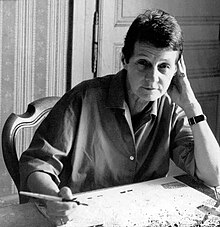Véronique Filozof
Véronique Filozof (born August 8, 1904 in Basel , † January 12, 1977 in Mulhouse ; original name: Veronika Sandreuter ) was a Swiss-French draftsman , illustrator and painter . She was the daughter of the coppersmith Rudolf Sandreuter and niece of the Basel painter Hans Sandreuter (1850–1901).
Life
During a language stay in France, she met Paul Modin; the couple married in 1923 and stayed in France, in Mulhouse since 1928, and divorced in 1936. In May 1940, Véronique Sandreuter married Georges Filozof, a Polish mining engineer from the Alsatian potash mines. They spent the war years in Sarlat in Périgord in southwestern France (Dordogne department). It was there that Véronique Filozof was inspired to create the picture series “Le Périgord Noir”; She captured rural life in this region in black and white ink drawings. In 1954 she made her breakthrough with this sequence in Paris; André Bloc published the works as a book. This was followed by a series of drawings of rural life and customs such as “La vie en Appenzell” or “Der Vogel Gryff” for the Basel Carnival. Together with Jean Cocteau she realized “Le Palais Royal”. The “Fables de La Fontaine” (1962) illustrated by Véronique Filozof was named the best Swiss book; she also artistically implemented the Parisian “May 1968” in her typical drawing style. Her most impressive work is "Der Totentanz / La dance macabre", for which she was inspired by Hans Holbein the Elder. J. was inspired. In the fifties she ran a small theater in the attic of her villa, the “Grenier Littéraire”, where she organized poetry readings and lectures, but also appeared in her own avant-garde performances.
literature
- Jean-Guy Modin: Véronique Filozof ma mère. Paris 1979.
- Maurice Allemand: Véronique Filozof. 1904-1977. Dessins - gouaches - livres illustrés [exhibition catalog]. La Haye 1979.
- Urs Amacher: The invitation cards of Véronique Filozof - artworks from the federal folder, in: Journal for Swiss Archeology and Art History, Volume 61 (2004) Issue 3, pp. 175–180.
| personal data | |
|---|---|
| SURNAME | Filozof, Véronique |
| ALTERNATIVE NAMES | Sandreuter, Veronika |
| BRIEF DESCRIPTION | Swiss-French illustrator |
| DATE OF BIRTH | August 8, 1904 |
| PLACE OF BIRTH | Basel |
| DATE OF DEATH | January 12, 1977 |
| Place of death | Mulhouse |
